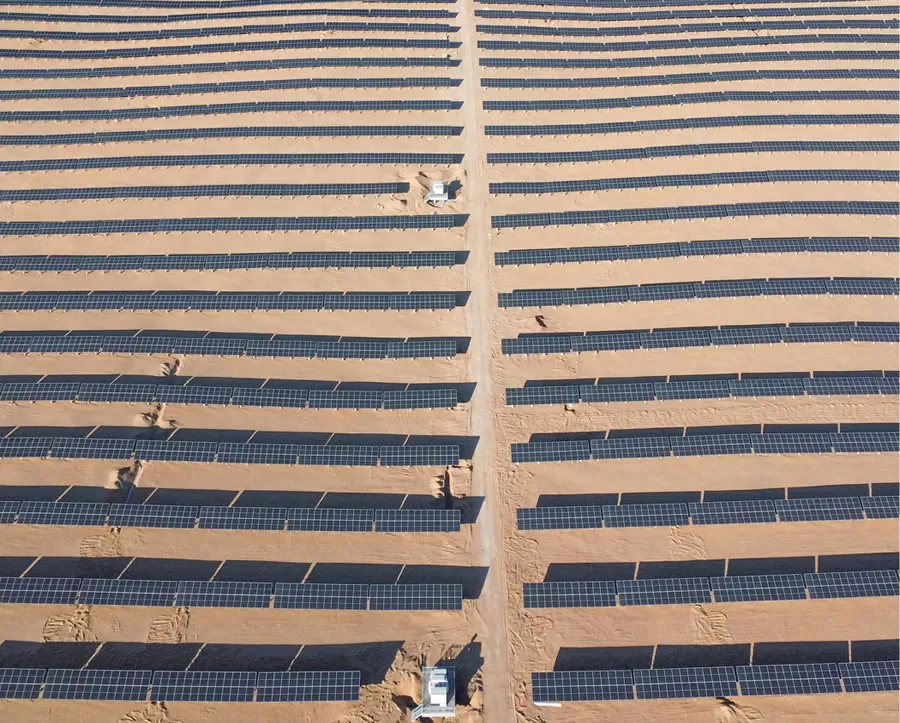
Aerial view of solar photovoltaic sand control in Hangjinqi, Inner Mongolia
The comprehensive implementation plan of photovoltaic sand control in Hangjinqi of Inner Mongolia is an innovative ecological project, combining photovoltaic power generation and desert control, effectively promoting the improvement of the ecological environment in the desert area and the development and utilization of solar photovoltaic new energy by means of the mode of “power generation on the board, planting under the board, and aquaculture between the boards”, and realizing multiple win-win ecological, economic and social benefits. It has achieved ecological, economic and social benefits, provided valuable experience for global desertification control, and has been widely recognized by the international community.
I. Project Background
Hangjinqi in Inner Mongolia is located in the northern edge of the Kubuqi Desert, with an average annual sunshine duration of 3,180 hours, sandy land accounted for more than 60%, and is the core area of the Yellow River's “several bends” sand prevention and sand control. 2 million kilowatts of photovoltaic sand control project in Kubuqi, launched in 2023, has already realized an annual supply of 4.1 billion kilowatts per year of green power, and the treatment of sand in an area of 100,000 mu, making it China's largest single photovoltaic project in terms of scale and size. It has become China's largest single-scale PV sand control benchmark project.
Ⅱ.Core Objectives
1. New Energy Transformation
In this project, 3 million kilowatts of solar photovoltaic power will be installed, and the annual power generation will be increased to 6.5 billion kilowatt-hours, which will cover 20% of the industrial power demand in Ordos City.
2. Ecological Restoration
It is expected that in 2025-2030, the area of the desert will be 246 square kilometers, and the annual average reduction of sand transfer from the Yellow River will be 4 million tons.
3. Industrial Integration
This project can realize the three-dimensional industry of “green power on the board, pasture between the boards, and medicinal herbs under the boards”, and drive farmers and herdsmen to increase their income by 30,000 yuan/household per year.
Ⅲ.Technical Programs
1. Synergistic design of photovoltaic and sand control
Utilizing the solar panel racking system, and adopting the 3-meter-high bracket off the ground, with an interval of 8 meters between panels, leaving enough space for vegetation growth and livestock activities.
Additional sand fixation technology:
Phase I laying of reed sand barriers with effective coverage higher than 90%, which can inhibit dune flow.
The second phase implements the minimally invasive airflow tree-planting method, planting drought-tolerant plants such as flower rods and sand willows, with the survival rate expected to be higher than 85%.
Recharge and utilize intelligent operation and maintenance:
Deploy UAV inspection system around solar panels to realize real-time monitoring of vegetation coverage, module temperature and other data MTTR within 2 hours.
2. Energy storage and grid configuration
|
Project |
Parameters |
Technical standard |
|
Energy Storage Capacity |
15% of installed capacity |
Lithium iron phosphate battery (cycle life≥6000 times) |
|
Grid Connection Mode |
Self-generation and self-consumption + surplus power on-grid |
GB/T 19964-202223 |
|
Power Transmission |
Supporting 500kV ultra-high voltage line |
Annual transmission capacity of 8 billion kilowatt-hours |
IV. Implementation Stage
1. Construction cycle in 2025-2027
In 2025, 1 million kilowatts of photovoltaic array laying will be completed, and 100,000 mu of sand barrier project will be launched simultaneously.
In 2026, it is expected to complete the energy storage and peaking power station (450,000 kW/900,000 kWh), and connect to the west Mongolian power grid.
In 2027, it is expected to realize the planting of 50,000 mu of economic crops such as bluegrass and alfalfa under the board.
2. Operation and maintenance management
Realize ecological monitoring, collect data such as soil water content and vegetation biomass every quarter, and dynamically adjust the planting program.
Actively promote community participation by training local herders to participate in PV module cleaning, with an average daily wage of RMB 200 for local labor, as well as medicinal herb harvesting.
V. Comprehensive Benefits
1. Economic benefits
Based on the local 0.5 Yuan/kWh, the annual power generation revenue is estimated at 3.25 billion RMB. According to the local carbon emission policy, calculated at 100 yuan/ton, the policy carbon trading income will reduce carbon dioxide emissions by 3.19 million tons per year, generating income of 319 million yuan.
2. Ecological benefits
As it is located at the edge of the desert, the rainfall in the local area has increased from 400mm to 800mm, and the wind speed has decreased by 1.5m/s. It is able to effectively increase the green vegetation coverage rate from 5% to 77%, and form a 20-kilometer ecological isolation zone.
3. Social Benefits
With the installation and commissioning of PV facilities, 12,000 new jobs can be created, 60% of which are for local farmers and herdsmen. Supporting the construction of 150 kilometers of roads, improve the transportation conditions of 6 townships, and can additionally enhance the economic construction.
VI. Risk Control
1. Policy risk:
Different countries and regions have different policies for solar PV. In China, the government of Inner Mongolia Autonomous Region has signed a 20-year Power Purchase Agreement (PPA), locking in a subsidy of RMB 0.35/kWh.
2. Technology Risk
Because it is located at the edge of the desert, the project adopts UL certified double-sided double-glass modules, which can reach 25 years of warranty period, and matching power generation insurance.
3. Ecological Risk
The project also reserves 5% of the land as ecological protection zone, which is prohibited to be covered by PV panels.
Ⅶ.Program Highlights
The Inner Mongolia Hangjinqi Solar Photovoltaic Sand Control Program realizes the cost per kWh of electricity to be reduced to RMB 0.2 yuan through the trinity mode of “PV array-ecological restoration-industrial hematopoietic”, which enhances the efficiency of the traditional sand control project by 3 times. The self-produced PV modules make the total cost lower, adopt the comprehensive solution of “product + system”, cover the whole life cycle of operation and maintenance management system, and reduce the intermediate links to bring higher compound benefits. The project experience has been incorporated into the “Technical Specification for Photovoltaic Sand Control in Northern China's Sand Control Belt”, providing a standardized template for similar areas.



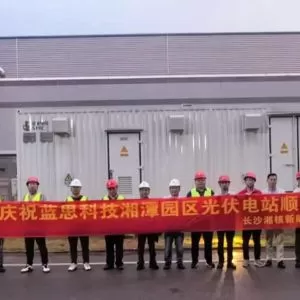


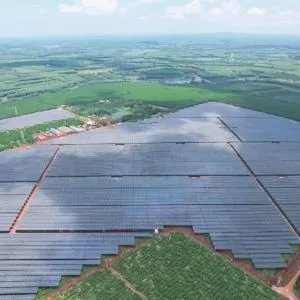
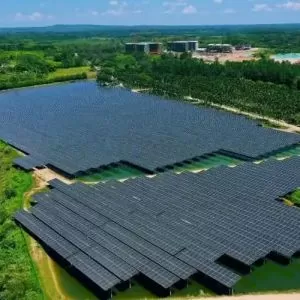
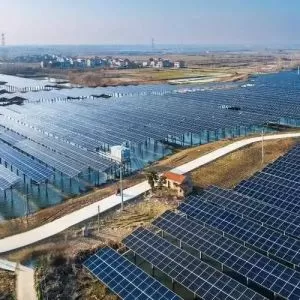

One step to find us,we will respond within 24 hours.
More Contact Details
008613738639386
[email protected]